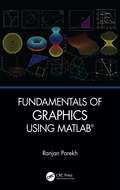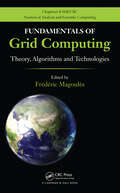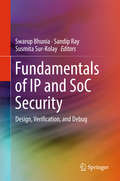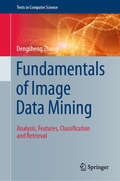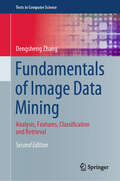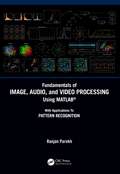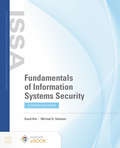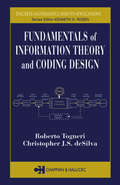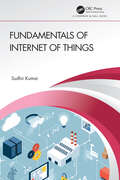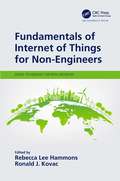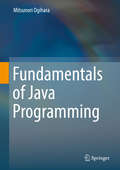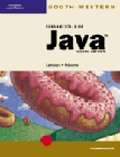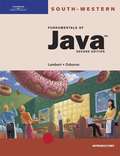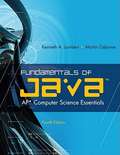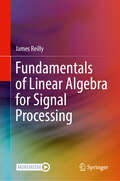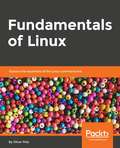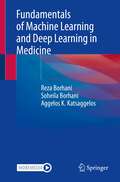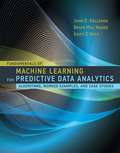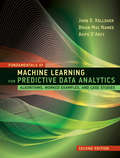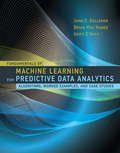- Table View
- List View
Fundamentals of Graphics Using MATLAB
by Ranjan ParekhThis book introduces fundamental concepts and principles of 2D and 3D graphics and is written for undergraduate and postgraduate students of computer science, graphics, multimedia, and data science. It demonstrates the use of MATLAB® programming for solving problems related to graphics and discusses a variety of visualization tools to generate graphs and plots. The book covers important concepts like transformation, projection, surface generation, parametric representation, curve fitting, interpolation, vector representation, and texture mapping, all of which can be used in a wide variety of educational and research fields. Theoretical concepts are illustrated using a large number of practical examples and programming codes, which can be used to visualize and verify the results. Key Features Covers fundamental concepts and principles of 2D and 3D graphics Demonstrates the use of MATLAB® programming for solving problems on graphics Provides MATLAB® codes as answers to specific numerical problems Provides codes in a simple copy and execute format for the novice learner Focuses on learning through visual representation with extensive use of graphs and plots Helps the reader gain in-depth knowledge about the subject matter through practical examples Contains review questions and practice problems with answers for self-evaluation
Fundamentals of Grid Computing: Theory, Algorithms and Technologies
by Frédéric MagoulèsThe integration and convergence of state-of-the-art technologies in the grid have enabled more flexible, automatic, and complex grid services to fulfill industrial and commercial needs, from the LHC at CERN to meteorological forecasting systems. Fundamentals of Grid Computing: Theory, Algorithms and Technologies discusses how the novel technologies
Fundamentals of High Frequency CMOS Analog Integrated Circuits
by Yusuf Leblebici Duran LeblebiciThis textbook is ideal for senior undergraduate and graduate courses in RF CMOS circuits, RF circuit design, and high-frequency analog circuit design. It is aimed at electronics engineering students and IC design engineers in the field, wishing to gain a deeper understanding of circuit fundamentals, and to go beyond the widely-used automated design procedures. The authors employ a design-centric approach, in order to bridge the gap between fundamental analog electronic circuits textbooks and more advanced RF IC design texts. The structure and operation of the building blocks of high-frequency ICs are introduced in a systematic manner, with an emphasis on transistor-level operation, the influence of device characteristics and parasitic effects, and input–output behavior in the time and frequency domains. This second edition has been revised extensively, to expand some of the key topics, to clarify the explanations, and to provide extensive design examples and problems. New material has been added for basic coverage of core topics, such as wide-band LNAs, noise feedback concept and noise cancellation, inductive-compensated band widening techniques for flat-gain or flat-delay characteristics, and basic communication system concepts that exploit the convergence and co-existence of Analog and Digital building blocks in RF systems. A new chapter (Chapter 5) has been added on Noise and Linearity, addressing key topics in a comprehensive manner. All of the other chapters have also been revised and largely re-written, with the addition of numerous, solved design examples and exercise problems.
Fundamentals of IP and SoC Security
by Sandip Ray Swarup Bhunia Susmita Sur-KolayThis book is about security in embedded systems and it provides an authoritative reference to all aspects of security in system-on-chip (SoC) designs. The authors discuss issues ranging from security requirements in SoC designs, definition of architectures and design choices to enforce and validate security policies, and trade-offs and conflicts involving security, functionality, and debug requirements. Coverage also includes case studies from the "trenches" of current industrial practice in design, implementation, and validation of security-critical embedded systems. Provides an authoritative reference and summary of the current state-of-the-art in security for embedded systems, hardware IPs and SoC designs; Takes a "cross-cutting" view of security that interacts with different design and validation components such as architecture, implementation, verification, and debug, each enforcing unique trade-offs; Includes high-level overview, detailed analysis on implementation, and relevant case studies on design/verification/debug issues related to IP/SoC security.
Fundamentals of Image Data Mining: Analysis, Features, Classification and Retrieval (Texts in Computer Science)
by Dengsheng ZhangThis reader-friendly textbook presents a comprehensive review of the essentials of image data mining, and the latest cutting-edge techniques used in the field. The coverage spans all aspects of image analysis and understanding, offering deep insights into areas of feature extraction, machine learning, and image retrieval. The theoretical coverage is supported by practical mathematical models and algorithms, utilizing data from real-world examples and experiments.Topics and features: describes the essential tools for image mining, covering Fourier transforms, Gabor filters, and contemporary wavelet transforms; reviews a varied range of state-of-the-art models, algorithms, and procedures for image mining; emphasizes how to deal with real image data for practical image mining; highlights how such features as color, texture, and shape can be mined or extracted from images for image representation; presents four powerful approaches for classifying image data, namely, Bayesian classification, Support Vector Machines, Neural Networks, and Decision Trees; discusses techniques for indexing, image ranking, and image presentation, along with image database visualization methods; provides self-test exercises with instructions or Matlab code, as well as review summaries at the end of each chapter.This easy-to-follow work illuminates how concepts from fundamental and advanced mathematics can be applied to solve a broad range of image data mining problems encountered by students and researchers of computer science. Students of mathematics and other scientific disciplines will also benefit from the applications and solutions described in the text, together with the hands-on exercises that enable the reader to gain first-hand experience of computing.
Fundamentals of Image Data Mining: Analysis, Features, Classification and Retrieval (Texts in Computer Science)
by Dengsheng ZhangThis unique and useful textbook presents a comprehensive review of the essentials of image data mining, and the latest cutting-edge techniques used in the field. The coverage spans all aspects of image analysis and understanding, offering deep insights into areas of feature extraction, machine learning, and image retrieval. The theoretical coverage is supported by practical mathematical models and algorithms, utilizing data from real-world examples and experiments. Topics and features: Describes essential tools for image mining, covering Fourier transforms, Gabor filters, and contemporary wavelet transformsDevelops many new exercises (most with MATLAB code and instructions)Includes review summaries at the end of each chapterAnalyses state-of-the-art models, algorithms, and procedures for image miningIntegrates new sections on pre-processing, discrete cosine transform, and statistical inference and testingDemonstrates how features like color, texture, and shape can be mined or extracted for image representationApplies powerful classification approaches: Bayesian classification, support vector machines, neural networks, and decision treesImplements imaging techniques for indexing, ranking, and presentation, as well as database visualization This easy-to-follow, award-winning book illuminates how concepts from fundamental and advanced mathematics can be applied to solve a broad range of image data mining problems encountered by students and researchers of computer science. Students of mathematics and other scientific disciplines will also benefit from the applications and solutions described in the text, together with the hands-on exercises that enable the reader to gain first-hand experience of computing.
Fundamentals of Image, Audio, and Video Processing Using MATLAB®: With Applications to Pattern Recognition
by Ranjan ParekhFundamentals of Image, Audio, and Video Processing Using MATLAB® introduces the concepts and principles of media processing and its applications in pattern recognition by adopting a hands-on approach using program implementations. The book covers the tools and techniques for reading, modifying, and writing image, audio, and video files using the data analysis and visualization tool MATLAB®. Key Features: Covers fundamental concepts of image, audio, and video processing Demonstrates the use of MATLAB® on solving problems on media processing Discusses important features of Image Processing Toolbox, Audio System Toolbox, and Computer Vision Toolbox MATLAB® codes are provided as answers to specific problems Illustrates the use of Simulink for audio and video processing Handles processing techniques in both the Spatio-Temporal domain and Frequency domain This is a perfect companion for graduate and post-graduate students studying courses on image processing, speech and language processing, signal processing, video object detection and tracking, and related multimedia technologies, with a focus on practical implementations using programming constructs and skill developments. It will also appeal to researchers in the field of pattern recognition, computer vision and content-based retrieval, and for students of MATLAB® courses dealing with media processing, statistical analysis, and data visualization. Dr. Ranjan Parekh, PhD (Engineering), is Professor at the School of Education Technology, Jadavpur University, Calcutta, India, and is involved with teaching subjects related to Graphics and Multimedia at the post-graduate level. His research interest includes multimedia information processing, pattern recognition, and computer vision.
Fundamentals of Information Systems
by Ralph Stair George ReynoldsGain an overview of the core principles of IS and how it is practiced today as the concise, nine-chapter FUNDAMENTALS OF INFORMATION SYSTEMS, 9th edition combines the latest research with the most current coverage available. The book addresses analytics; big data; business intelligence; cloud computing; cybercrime and information system security; e-commerce; enterprise systems; ethical, legal, and social issues of information systems; mobile computing solutions; and systems acquisition and development. You learn how information systems can increase profits and reduce costs as you explore the latest information on artificial intelligence, change management, consumerization of information systems, data governance, energy and environmental concerns, global IS challenges, Internet of Everything, Internet censorship and net neutrality, IS careers, and virtual teams. Leading online MindTap help you further maximize success as an employee, decision maker, and business leader.
Fundamentals of Information Systems Security
by David Kim Michael G. SolomonFundamentals of Information Systems Security, Fourth Edition provides a comprehensive overview of the essential concepts readers must know as they pursue careers in information systems security.
Fundamentals of Information Systems Security
by David Kim Michael G. SolomonThe cybersecurity landscape is evolving, and so should your curriculum. Fundamentals of Information Systems Security, Fifth Edition helps instructors teach the foundational concepts of IT security while preparing students for the complex challenges of today’s AI-powered threat landscape. This updated edition integrates AI-related risks and operational insights directly into core security topics, providing students with the tools to think critically about emerging threats and ethical use of AI in the classroom and beyond. The Fifth Edition is organized to support seamless instruction, with clearly defined objectives, an intuitive chapter flow, and hands-on cybersecurity Cloud Labs that reinforce key skills through real-world practice scenarios. It aligns with CompTIA Security+ objectives and maps to CAE-CD Knowledge Units, CSEC 2020, and the updated NICE v2.0.0 Framework. From two- and four-year colleges to technical certificate programs, instructors can rely on this resource to engage learners, reinforce academic integrity, and build real-world readiness from day one. Features and Benefits Integrates AI-related risks and threats across foundational cybersecurity principles to reflect today’s threat landscape. Features clearly defined learning objectives and structured chapters to support outcomes-based course design. Aligns with cybersecurity, IT, and AI-related curricula across two-year, four-year, graduate, and workforce programs. Addresses responsible AI use and academic integrity with reflection prompts and instructional support for educators. Maps to CompTIA Security+, CAE-CD Knowledge Units, CSEC 2020, and NICE v2.0.0 to support curriculum alignment. Offers immersive, scenario-based Cloud Labs that reinforce concepts through real-world, hands-on virtual practice. Instructor resources include slides, test bank, sample syllabi, instructor manual, and time-on-task documentation.
Fundamentals of Information Theory and Coding Design (Discrete Mathematics and Its Applications)
by Roberto Togneri Christopher J.S deSilvaBooks on information theory and coding have proliferated over the last few years, but few succeed in covering the fundamentals without losing students in mathematical abstraction. Even fewer build the essential theoretical framework when presenting algorithms and implementation details of modern coding systems.Without abandoning the theoret
Fundamentals of Internet of Things
by Sudhir KumarThe Internet of Things (IoT) networks have revolutionized the world and have innumerable real-time applications on automation. A few examples include driverless cars, remote monitoring of the elderly, remote order of tea or coffee of your choice from a vending machine, and home/industrial automation amongst others. Fundamentals of Internet of Things build the foundations of IoT networks by leveraging the relevant concepts from signal processing, communications, net-works, and machine learning. The book covers two fundamental components of IoT networks, namely, the Internet and Things. In particular, the book focuses on networking concepts, protocols, clustering, data fusion, localization, energy harvesting, control optimization, data analytics, fog computing, privacy, and security including elliptic curve cryptography and blockchain technology. Most of the existing books are theoretical and without many mathematical details and examples. In addition, some essential topics of the IoT networks are also missing in the existing books. Features: • The book covers cutting-edge research topics• Provides mathematical understanding of the topics in addition to relevant theory and insights• Includes illustrations with hand-solved numerical examples for visualization of the theory and testing of understanding• Lucid and crisp explanation to lessen the study time of the reader The book is a complete package of the fundamentals of IoT networks and is suitable for graduate-level students and researchers who want to dive into the world of IoT networks.
Fundamentals of Internet of Things for Non-Engineers (Technology for Non-Engineers)
by Ronald J. Kovac Rebecca Lee HammonsThe IoT is the next manifestation of the Internet. The trend started by connecting computers to computers, progressed to connecting people to people, and is now moving to connect everything to everything. The movement started like a race—with a lot of fanfare, excitement, and cheering. We’re now into the work phase, and we have to figure out how to make the dream come true. The IoT will have many faces and involve many fields as it progresses. It will involve technology, design, security, legal policy, business, artificial intelligence, design, Big Data, and forensics; about any field that exists now. This is the reason for this book. There are books in each one of these fields, but the focus was always "an inch wide and a mile deep." There’s a need for a book that will introduce the IoT to non-engineers and allow them to dream of the possibilities and explore the work venues in this area. The book had to be "a mile wide and a few inches deep." The editors met this goal by engaging experts from a number of fields and asking them to come together to create an introductory IoT book. Fundamentals of Internet of Things for Non-Engineers Provides a comprehensive view of the current fundamentals and the anticipated future trends in the realm of Internet of Things from a practitioner’s point of view Brings together a variety of voices with subject matter expertise in these diverse topical areas to provide leaders, students, and lay persons with a fresh worldview of the Internet of Things and the background to succeed in related technology decision-making Enhances the reader’s experience through a review of actual applications of Internet of Things end points and devices to solve business and civic problems along with notes on lessons learned Prepares readers to embrace the Internet of Things era and address complex business, social, operational, educational, and personal systems integration questions and opportunities
Fundamentals of Java Programming
by Mitsunori OgiharaMaking extensive use of examples, this textbook on Java programming teaches the fundamental skills for getting started in a command-line environment. Meant to be used for a one-semester course to build solid foundations in Java, Fundamentals of Java Programming eschews second-semester content to concentrate on over 180 code examples and 250 exercises.Key object classes (String, Scanner, PrintStream, Arrays, and File) are included to get started in Java programming. The programs are explained with almost line-by-line descriptions, also with chapter-by-chapter coding exercises.Teaching resources include solutions to the exercises, as well as digital lecture slides.
Fundamentals of Java: Comprehensive Course
by Kenneth Lambert Martin OsborneCompletely revised and updated, Fundamentals of Java: Comprehensive Course covers all of the AP requirements for Computer Science Exams A and AB. By taking a multilevel approach to teaching Java, this text is suitable for a wide range of students, from beginners to those ready for advanced data structures. Since it is non-software specific, it can be used with any Java program compiler, including Borland, Sun Microsystems, Symantec and others.
Fundamentals of Java: Introductory Course (2nd Edition)
by Kenneth Lambert Martin OsborneCompletely revised and updated, Fundamentals of Java: Introductory Course, Second Edition now covers all of the AP requirements for Computer Science Exam A. Clear, practical explanations guide students through even the most complex programming topic. Since it is non-software specific, it can be used with any Java program compiler, including Borland, Sun Microsystems, Symantec and others.
Fundamentals of JavaTM: AP® Computer Science Essentials
by Kenneth Lambert Martin OsborneFundamentals of Java#xE2;#x1E;#xA2;: AP* Computer Science Essentials, Fourth Edition covers all of the AP requirements for Computer Science Exam A.
Fundamentals of Linear Algebra for Signal Processing
by James ReillySignal processing is ubiquitous in many fields of science and engineering. This textbook is tailored specifically for graduate students and presents linear algebra, which is requisite knowledge in these fields, in a form explicitly targeted to signal processing and related disciplines. Written by an experienced author with over 35 years of expertise in signal processing research and teaching, this book provides the necessary foundation in a focused and accessible manner, offering a practical approach to linear algebra without sacrificing rigor. Emphasis is placed on a deeper conceptualization of material specific to signal processing so students may more readily adapt this knowledge to actual problems in the field. Since other emerging areas, such as machine learning, are closely related to signal processing, the book also provides the necessary background in this discipline. The book includes many examples and problems relevant to signal processing, offering explanations and insights that are difficult to find elsewhere. Fundamentals of Linear Algebra for Signal Processing will allow students to master the essential knowledge of linear algebra for signal processing. It is also an essential guide for researchers and practitioners in biomedical, electrical, chemical engineering, and related disciplines.
Fundamentals of Linux: Explore the essentials of the Linux command line
by Oliver PelzDevelop a solid understanding of the important command-line tools and utilities in LinuxKey FeaturesDelve into the fundamentals of LinuxExplore and work with virtualization, command lines, and Bash shell scriptsUse special file permission flags such as setuid and setgidBook DescriptionLinux is a Unix-like operating system assembled under the model of free and open source software development and distribution. Fundamentals of Linux will help you learn all the essentials of the Linux command line required to get you started. The book will start by teaching you how to work with virtualization software and install CentOS 7 Linux as a VM. Then, you will get to grips with the workings of various command line operations, such as cursor movement, commands, options, and arguments. As you make your way through the chapters, the book will not only focus on the most essential Linux commands but also give an introduction to Bash shell scripting. Finally, you will explore advanced topics, such as networking and troubleshooting your system, and you will get familiar with the advanced file permissions: ACL, setuid, and setgid. Fundamentals of Linux includes real-world tasks, use cases, and problems that, as a system administrator, you might encounter in your day-to-day activities.What you will learnExplore basic and advanced command-line conceptsInstall Linux, work with VirtualBox, and install CentOS 7 in VirtualBox Work with the command line efficiently and learn how to navigate through the Linux filesystemCreate file and user group permissions and edit filesUse Sticky bit to secure your Linux filesystemDefine and remove ACL from Linux filesWho this book is forFundamentals of Linux is for individuals looking to work as a Linux system administrator.
Fundamentals of Machine Learning and Deep Learning in Medicine
by Reza Borhani Aggelos K. Katsaggelos Soheila BorhaniThis book provides an accessible introduction to the foundations of machine learning and deep learning in medicine for medical students, researchers, and professionals who are not necessarily initiated in advanced mathematics but yearn for a better understanding of this disruptive technology and its impact on medicine. Once an esoteric subject known to few outside of computer science and engineering departments, today artificial intelligence (AI) is a widely popular technology used by scholars from all across the academic universe. In particular, recent years have seen a great deal of interest in the AI subfields of machine learning and deep learning from researchers in medicine and life sciences, evidenced by the rapid growth in the number of articles published on the topic in peer-reviewed medical journals over the last decade. The demand for high-quality educational resources in this area has never been greater than it is today, and will only continue to grow at a rapid pace. Expert authors remove the veil of unnecessary complexity that often surrounds machine learning and deep learning by employing a narrative style that emphasizes intuition in place of abstract mathematical formalisms, allowing them to strike a delicate balance between practicality and theoretical rigor in service of facilitating the reader’s learning experience. Topics covered in the book include: mathematical encoding of medical data, linear regression and classification, nonlinear feature engineering, deep learning, convolutional and recurrent neural networks, and reinforcement learning. Each chapter ends with a collection of exercises for readers to practice and test their knowledge. This is an ideal introduction for medical students, professionals, and researchers interested in learning more about machine learning and deep learning. Readers who have taken at least one introductory mathematics course at the undergraduate-level (e.g., biostatistics or calculus) will be well-equipped to use this book without needing any additional prerequisites.
Fundamentals of Machine Learning for Predictive Data Analytics
by John D. Kelleher Aoife D'Arcy Brian Mac NameeMachine learning is often used to build predictive models by extracting patterns from large datasets. These models are used in predictive data analytics applications including price prediction, risk assessment, predicting customer behavior, and document classification. This introductory textbook offers a detailed and focused treatment of the most important machine learning approaches used in predictive data analytics, covering both theoretical concepts and practical applications. Technical and mathematical material is augmented with explanatory worked examples, and case studies illustrate the application of these models in the broader business context.After discussing the trajectory from data to insight to decision, the book describes four approaches to machine learning: information-based learning, similarity-based learning, probability-based learning, and error-based learning. Each of these approaches is introduced by a nontechnical explanation of the underlying concept, followed by mathematical models and algorithms illustrated by detailed worked examples. Finally, the book considers techniques for evaluating prediction models and offers two case studies that describe specific data analytics projects through each phase of development, from formulating the business problem to implementation of the analytics solution. The book, informed by the authors' many years of teaching machine learning, and working on predictive data analytics projects, is suitable for use by undergraduates in computer science, engineering, mathematics, or statistics; by graduate students in disciplines with applications for predictive data analytics; and as a reference for professionals.
Fundamentals of Machine Learning for Predictive Data Analytics, second edition: Algorithms, Worked Examples, and Case Studies
by John D. Kelleher Aoife D'Arcy Brian Mac NameeThe second edition of a comprehensive introduction to machine learning approaches used in predictive data analytics, covering both theory and practice.Machine learning is often used to build predictive models by extracting patterns from large datasets. These models are used in predictive data analytics applications including price prediction, risk assessment, predicting customer behavior, and document classification. This introductory textbook offers a detailed and focused treatment of the most important machine learning approaches used in predictive data analytics, covering both theoretical concepts and practical applications. Technical and mathematical material is augmented with explanatory worked examples, and case studies illustrate the application of these models in the broader business context. This second edition covers recent developments in machine learning, especially in a new chapter on deep learning, and two new chapters that go beyond predictive analytics to cover unsupervised learning and reinforcement learning.
Fundamentals of Machine Learning for Predictive Data Analytics: Algorithms, Worked Examples, and Case Studies (The\mit Press Ser.)
by John D. Kelleher Aoife D'Arcy Brian Mac NameeA comprehensive introduction to the most important machine learning approaches used in predictive data analytics, covering both theoretical concepts and practical applications.Machine learning is often used to build predictive models by extracting patterns from large datasets. These models are used in predictive data analytics applications including price prediction, risk assessment, predicting customer behavior, and document classification. This introductory textbook offers a detailed and focused treatment of the most important machine learning approaches used in predictive data analytics, covering both theoretical concepts and practical applications. Technical and mathematical material is augmented with explanatory worked examples, and case studies illustrate the application of these models in the broader business context.After discussing the trajectory from data to insight to decision, the book describes four approaches to machine learning: information-based learning, similarity-based learning, probability-based learning, and error-based learning. Each of these approaches is introduced by a nontechnical explanation of the underlying concept, followed by mathematical models and algorithms illustrated by detailed worked examples. Finally, the book considers techniques for evaluating prediction models and offers two case studies that describe specific data analytics projects through each phase of development, from formulating the business problem to implementation of the analytics solution. The book, informed by the authors' many years of teaching machine learning, and working on predictive data analytics projects, is suitable for use by undergraduates in computer science, engineering, mathematics, or statistics; by graduate students in disciplines with applications for predictive data analytics; and as a reference for professionals.
Fundamentals of Machine Theory and Mechanisms
by Antonio Simón Mata Alex Bataller Torras Juan Antonio Cabrera Carrillo Francisco Ezquerro Juanco Antonio Jesús Guerra Fernández Fernando Nadal Martínez Antonio Ortiz FernándezThis book develops the basic content for an introductory course in Mechanism and Machine Theory. The text is clear and simple, supported by more than 350 figures. More than 60 solved exercises have been included to mark the translation of this book from Spanish into English. Topics treated include: dynamic analysis of machines; introduction to vibratory behavi∨ rotor and piston balanced; critical speed for shafts; gears and train gears; synthesis for planar mechanisms; and kinematic and dynamic analysis for robots. The chapters in relation to kinematics and dynamics for planar mechanisms can be studied with the help of WinMecc software, which allows the reader to study in an easy and intuitive way, but exhaustive at the same time. This computer program analyzes planar mechanisms of one-degree of freedom and whatever number of links. The program allows users to build a complex mechanism. They can modify any input data in real time changing values in a numeric way or using the computer mouse to manipulate links and vectors while mechanism is moving and showing the results. This powerful tool does not only show the results in a numeric way by means of tables and diagrams but also in a visual way with scalable vectors and curves.
Fundamentals of Magnonics (Lecture Notes in Physics #969)
by Sergio M. RezendeFundamentals of Magnonics is a textbook for beginning graduate students in the areas of magnetism and spintronics. The level of presentation assumes only basic knowledge of the origin of magnetism and electromagnetism, and quantum mechanics. The book utilizes elementary mathematical derivations, aimed mainly at explaining the physical concepts involved in the phenomena studied and enabling a deeper understanding of the experiments presented. Key topics include the basic phenomena of ferromagnetic resonance in bulk materials and thin films, semi-classical theory of spin waves, quantum theory of spin waves and magnons, magnons in antiferromagnets, parametric excitation of magnons, nonlinear and chaotic phenomena, Bose-Einstein condensation of magnons, and magnon spintronics. Featuring end-of-chapter problem sets accompanied by extensive contemporary and historical references, this book provides the essential tools for any graduate or advanced undergraduate-level course of studies on the emerging field of magnonics.
